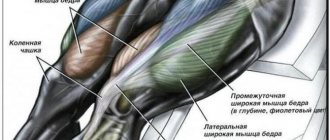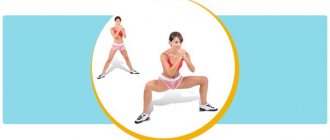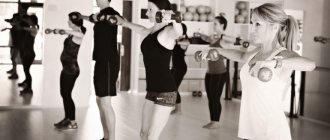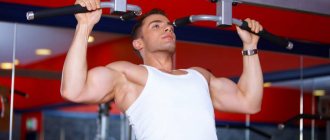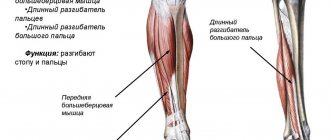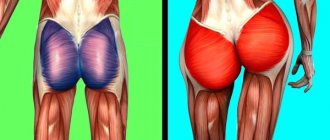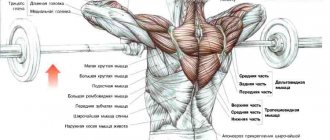Well-developed pectoral muscles are a source of pride for their owner. You don't even need to have big and pumped up biceps, ripped abs and broad back muscles.
Powerful and sculpted breasts will definitely make you stand out from the crowd. However, it is not so easy to achieve the desired result. Why do most beginners still fail? There may be several reasons for this. It will also be helpful for you to read the previous article: “Anatomy of the muscles of the human arms.”
Anatomy
First, let's touch a little on the science of anatomy.
Before you start exercising, it is very important to know the structure and functions of your body, so that in the future you can do everything correctly and not overload yourself with unnecessary physical activity.
All chest muscles consist of three groups, let's learn more about them.
The pectoralis major muscle is located in front of the chest; during training, it plays the most important role, because it takes on the main load.
The pectoralis minor muscle is located directly under the pectoralis major muscle and is closely connected with it; it is its assistant in the work of the chest. Its main function is to move the shoulder.
To the question: is it possible to pump up the breasts? Of course it is possible, because strengthening muscles has never harmed a person, but on the contrary, it has benefited him.
Pump up your chest
Oddly enough, not only girls, but also men want to pump up their breasts The principles of training are directly opposite, this applies to all muscle groups, but especially in this case. If women focus on the upper bundle of pectoral muscles and stretching exercises, then men increase the mass of the lower bundle of pectoral muscles, but first things first.
The pectoral muscles are a large muscle group, which is conventionally divided into three parts: the upper pectoral muscles, the lower chest and the middle of the chest. This is important to know in order to pump up your breasts. The lower part of the pectoral muscles is the most developed genetically, therefore it steals the lion's share of the load.
This happens always and everywhere - a stronger muscle, other things being equal, always takes on more load than weaker muscles. In this way, the body saves energy, and it uses weaker muscles only when a strong muscle can no longer cope with the load.
Therefore, in order to pump up the chest evenly, the athlete has to perform special exercises that force the body to pump those areas of the pectoral muscles that it usually does not strain.
To do this, use an inclined bench, hand position, dumbbells and other tricks.
But training the pectoral muscles varies in its objectives; it can pursue the goal of building muscle mass, adjusting proportions, increasing strength and “drying”. In this regard, the training program will differ.
Pump up your chest: mass
To build muscle mass in the pectoral muscles, you must perform basic exercises, with an emphasis on the target muscles. The first thing here is technology. If, when training strength indicators, you must include many muscle groups, then the situation is exactly the opposite.
You can pump up your chest with three exercises: bench press, angled press, and wide-grip parallel bars with additional weights. In this case, it is necessary to observe microperiodization.
The chest can be pumped twice a week, with training programs aimed at pumping the chest.
It will be best if at the beginning of the week you do the bench press for four working sets of 8 reps, and at the end of the week, two days before your next chest workout, weighted bars and incline presses in the 12 rep range.
Pay attention!
This training scheme will allow you to progress the load, on the one hand, and on the other hand, pump up lagging areas of the pectoral muscles, which will make it possible to evenly pump up your chest.
The leading bundle of the pectorals is the lower chest, the top and middle lag behind. Therefore, the athlete should perform the bench press, which pumps up the bottom, with a barbell, and the angled press with dumbbells.
Weighted bars help to pump up the middle of the chest perfectly.
When training for mass, you must perform the exercise with appropriate technique. During the bench press, your feet should be on the bench, and your elbows should be spread out to the sides so that when the barbell touches your chest, they form an angle of 90°. Using dumbbells while pressing at an angle will allow you to engage the stabilizer muscles, which will help deepen the load.
But you shouldn’t do isolation exercises! Leave this until you get around to adjusting the proportions.
Now remember , we train only with basic exercises, we train the chest twice a week, we don’t try to take more weight than we can, but we monitor the technique and focus the load on the pectoral muscles. Follow these rules, and pumping up your breasts will not be difficult!
Pump up your breasts: quality
Unlike gaining muscle mass, where the athlete is interested in the massiveness of the muscles, in this case they are interested in their shape. There are two reasons why an athlete may wonder about adjusting their proportions: some area of the pecs is lagging behind, or the athlete has a narrow bone structure.
In the first case, either the upper bundle of the pectoral muscles or the middle of the chest may lag behind. Accordingly, it is necessary to do the exercises that can help restore the imbalance. First of all, these are angled presses and weighted parallel bars. But the bench press will have to be excluded. Instead of the bench press, include the head down press and dumbbell flyes in your training program.
You already know the functions that parallel bars and an angle press perform - these exercises allow you to pump up your chest.
Dumbbell flyes allow you to stretch the pectoral muscles and place a good emphasis on the load in the middle of the chest.
It is important!
The upside down press pumps up the bottom of the chest and feet, but just now we were talking about the fact that the bottom of the chest is always in the lead anyway! Right! But this exercise will help to draw the bottom of the pectoral muscles, lifting the chest up.
To expand your core, you will have to devote a separate workout. It is important to note that pumping your breasts in this way only makes sense if your growth zones have not yet closed, which means up to 25 years.
The essence of the training is to expand the chest. To do this, you will need a superset, which consists of squats with a barbell and a pullover.
This workout will not only pump up your chest, but will enhance the effectiveness of all chest muscle training.
Barbell squats should be performed with a light weight in the 20 rep range while breathing deeply. You may even need the pranayama technique, you should inhale as deeply as possible and exhale quickly with effort.
One repetition should take at least 6 seconds. After you do a set of squats, you need to move on to the pullover.
You will also perform the pullover while breathing deeply, doing the exercise for at least 12 repetitions in one approach.
Perhaps, mass training and chest correction can be combined into one system, in which at the beginning you pump up muscle mass, and then correct their shape. It is important to follow the correct technique, which allows you to improve neuroconnection, and the sequence of training.
Helpful advice!
But remember that these are the basic rules for training the pectoral muscles; in order to pump up your chest or other muscle group, you need to choose the right training program that will suit you. After all, you may enter a phase of overtraining, or a plateau, perhaps you have reached your genetic limit, etc.
Interesting: How to pump up the muscles of the forearm
Therefore, following the basic training recommendations, choose the training program that will be most effective for you at the moment.
Pump up your chest: strength
It is necessary to train the strength of the pectoral muscles by performing basic exercises, but unlike mass training, in a low frequency number of repetitions. We're talking about the bench press.
In this case, the exercise technique will be specific, you will have to make a bridge, bring your shoulder blades together, turn your elbows towards the body, lowering the barbell, you will touch the solar plexus, and your hands will be pressed to the body.
With this technique, most of the load will be received by the triceps, latissimus dorsi, legs and shoulders, which does not really help pump up the chest. But you will be able to lift more weight, which will stimulate your fast-twitch muscle fibers to grow. Often bodybuilders neglect this technique, because this is an exercise for powerlifters, but they do it in vain. The fact is that micro and macro periodization are very useful.
The more varied load you give your muscles, the more effective the workout. The body has to adapt, so you are less likely to hit a plateau.
Since the load is different, the chance of overtraining is also less. Moreover, by increasing strength indicators, you will be able to more easily progress the load when training your chest for weight.
Therefore, it is easier to pump up your chest by training different muscle qualities than to “pound” the same training program.
"Drying"
It is necessary to train your chest even when you are trying to burn subcutaneous fat. But getting rid of excess weight is not a matter of a training program, but a matter of dieting for weight loss.
In this case, a sports diet would be the most appropriate; as for the pectoral muscles during this period, the training program should be aimed at preserving muscles, and not at getting rid of fat, and it is even more pointless to try to pump up the chest.
Forget about aerobic exercise! If you do not take anabolic steroids, you will simply “burn” all your muscles. On the contrary, you should train with heavy training weights. It is best to do the bench press for 6-8 reps.
Otherwise, in conditions of calorie deficit, the body will use muscle rather than fat as energy.
Muscles are full of glycogen, so if you don’t force your body to think that muscles are vital to it, then it will “eat” them first.
Build muscles
Source: https://Fit4Power.ru/shema/nakaceatigrudi
How to pump up wide chest?
It is interesting to know that in ancient times, wide chests in men were considered a sign of omnipotence and success. Now you have a basic understanding of the anatomy of the pectoral muscles, we can continue.
In order to pump up your wide chest, we recommend that you visit the gym, where you will be constantly under the supervision of a competent person who, if necessary, can always back you up and give you practical advice.
During your first workouts, you should not start working with heavy weights, start with small ones, and then gradually increase them.
Why are breasts different sizes?
Congenital causes include hypoplasia (delayed development) of glandular tissue, hormonal problems during puberty. In girls at the age of 9–10, the ovaries begin to produce the hormones estrogen and progesterone, which are responsible for the development of glandular tissue, alveoli, and milk ducts. With their deficiency or excess, the bust may develop disproportionately. The exact reason why the breasts are different will be determined by a mammologist or endocrinologist. If treatment has been completed by the age of 18–19 and significant asymmetry remains, you can contact a plastic surgeon.
Acquired causes include the following:
- Lactation . Most often, breasts become different sizes during feeding when, due to a nipple injury or inattention, a woman gives the baby predominantly one breast.
- Mastopathy . Hormonal disruptions in women after 30 years lead to the proliferation of breast tissue - diffuse or nodular mastopathy, affecting the volume of the bust.
- Neoplasms . After surgery to remove a benign or malignant tumor, the breast loses volume and needs to be restored.
- Bust drooping . With age, the pectoral muscles become less elastic, and the glandular tissue loses volume. The process may occur unevenly in both breasts.
Barbell exercises
A very powerful projectile that really gives excellent results. Many boys and men do not know how to pump their chest muscles correctly using a dumbbell.
To begin, take a lying position on your back, then take the crossbar and smoothly begin to lift it, in this matter the main thing is not to overdo it.
If you feel that your strength is leaving you and it becomes more and more difficult for you to do the exercise each time, then stop the exercise.
Working with heavy loads requires maximum concentration and caution, especially with such a projectile. Failure to follow this rule could result in very serious injury.
Breast pumping at home
We live in a world where not everyone has the financial means to go to the gym and work out individually with a trainer.
There is a way out of this situation. You can pump up your chest at home, you don’t have to use a barbell bench press for this, the following are perfect:
- Push ups
- Pull-up on the bar
- Work with dumbbells
Very often in many chats, men are interested in how to pump up their chest with dumbbells at home?
- You can pump your chest while sitting on the edge of a chair using a dumbbell; it is important to do several approaches and do the exercise 15-20 times.
- Lying on the floor with your arms spread to the side.
Push ups
Next we will talk about how to pump up your chest with push-ups. Push-ups are an old and proven way that you are guaranteed to be able to pump up your chest and body as a whole.
It is important to do push-ups every day and do them several times. Ideally, this will be 7-8 approaches 25-30 times a day.
First, take the correct body position, your arms should be straight (not bent), the exercises are done smoothly.
Do not allow your body to bend down, otherwise there will be no effect.
Exercises on the horizontal bar
Next we pump the chest on the horizontal bar. We recommend installing a crossbar at your home - it will make your life much easier; you can practice at home in any weather.
Exercising on the horizontal bar perfectly pumps the muscles of the chest, back and arms. By exercising on one apparatus, you pump 3 parts of the body at once. Just like in push-ups, you need to take the correct body position.
Firmly fix your hands on the bar, and with light movements begin to pull yourself up, do 10 sets of 10 times. After just a month of active physical activity, you will be able to experience significant results.
First of all, the back muscles will become more noticeably stronger, the chest will become more convex and prominent, the arms will become larger and stronger.
Exercising on the horizontal bar helps eliminate curvature in the spine. Constant exercises on the bar will make your spine straight and strong.
Number of repetitions
For each exercise you need to follow its own rules. It’s better not to overdo it in this matter, because you will only make things worse for yourself and stop your progress in gaining muscle mass.
Professional athletes know how many times to pump their chest.
One American bodybuilder shared his experience in this matter. He said “The chest is the most important element in the transformation of your body, so you need to place special emphasis on it. Personally, I train my chest muscles 2 times a week, no more.
My first workout goes completely to the point of losing strength, I come home and can’t do anything. After a good and complete rest, the muscles return to normal, and strength is restored, and accordingly, the chest muscles grow.
At the end of the week I start breast pumping again. But I’m already pumping it up not to the point of complete loss of strength, but to about 50% of total fatigue.
Such training at one time helped me transform from an ordinary skinny guy into a superman, who is now the envy of many.”
How to pump up the pectoral muscles, a set of exercises
To optimally pump up your pectoral muscles, do one basic exercise for the upper part of the pectoral muscles and one basic exercise for the sternum. Supplement them with one or two shapers for each part of the pectoral muscle. You need to perform these sets of exercises at least 2-3 times a week every 1-2 days. It is better to regulate the load in stages: on the first day - high. On the second day - low (less weight and number of repetitions, do not give all your best). On the third day - average (do not give all your best, but do not relax either). This is a universal recipe for success in the gym, which allows you not to overtrain and quickly progress in strength and mass.
This is what a complex for beginners might look like
Bench press on a horizontal bench – 3x12
Incline dumbbell bench press – 2-3x12
A set of exercises for the pectoral muscles for intermediate levels
Bench press on a horizontal bench – 4x10-12
Bench press on an incline bench – 4x10-12
Lying dumbbell fly – 3x10-12
A set of exercises for the chest muscles for experienced
Bench press on a horizontal bench – 4-5x8-10
Incline dumbbell bench press – 4x8-10
Dips – 3x8-10
Pull-over – 2-3x12-15
Nutrition
During training, follow a proper and balanced diet. Eat boiled meat, add fresh vegetables and fruits to your dishes.
Also, don’t forget about dairy products; consuming them helps speed up muscle gain and strengthens your bones.
If you are a person who is prone to thinness, we advise you to consume as many calories as possible per day, you are lucky, you can eat whatever you want.
And if you are a person who is prone to obesity, then consume fewer calories than you burned during training.
Such people are strictly prohibited from eating sweet, fatty or fried foods. Strictly monitor your diet and drink as much purified water as possible.
Workout 1
If you want to build muscle mass and increase the thickness of your pectoral muscles, you need to start with incline presses. Like most guys, I love the flat bench press, but nothing beats the incline bench press for dynamic and amazing chest development.
It strengthens the pectoral muscle from the collarbone to the sternum and helps eliminate that sagging chest appearance that has developed over the years with your "flat bench is the name of the game" philosophy.
The first is the hardest of the two workouts during the week where you will perform presses and push-ups. These are multi-joint movements, which allows you to work more muscles at the same time in an exercise. We will leave the isolation exercise like dumbbell flyes for the second lesson with a higher number of repetitions.
Workout Notes: Perform all three exercises in a circuit, one after the other, like a triset. After one warm-up set using light weights (except push-ups), use a weight that is approximately 80-85% of your personal one-repetition maximum (1RM).
Rest 90 seconds between circles. Be sure to rest for at least 48-72 hours before your next shoulder and/or chest workout.
- Incline bench press – 4 sets of 6 reps.
- Dumbbell bench press – 4 sets of 8 reps.
- Push-ups – 4 sets of 6 reps. *
*Spend 8 seconds on the eccentric portion of each repetition. If the exercise is too easy, increase the weight with a weighted vest or have a partner place barbell plates on your back.

